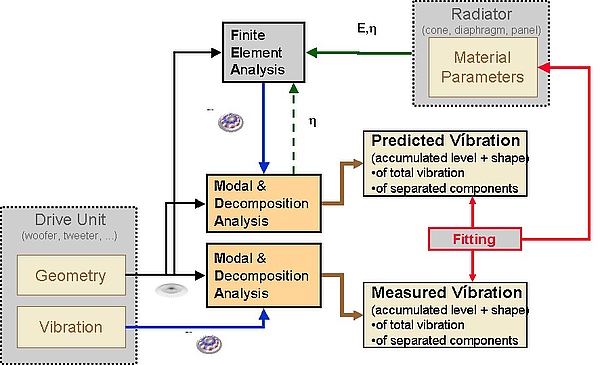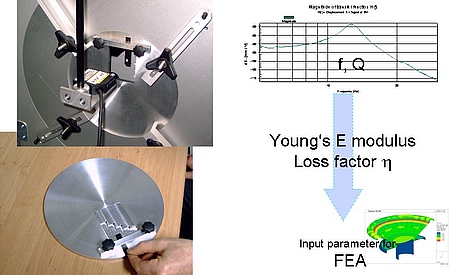特性: | KLIPPEL R&D系统 |
|---|---|
| 杨氏E模量 | MPM |
| 模态损耗因子η | MPM, SCN, HMA |
KLIPPEL R&D系统 (开发)
模组 | 备注 |
|---|---|
| 材料参数测量 (MPM) | MPM通过使用振动条束技术动态测量平坦材料样品的杨氏E模量和损耗因子η。这些参数在低频(<100Hz)处测量,也应该在这些频率处被应用到FEA中。然而,该简单技术对检查材料性能一致性很有帮助,也简化了驱动单元和软部件制造商之间的交流。 |
SCN给出最终应用中所用形状部件的固有频率和模态损耗因子。将有限元模型预测的固有频率拟合到被测频率,来找到杨氏E模量。该方法给出了最可靠的结果,并显示了音频带中参数对频率的依赖性。 | |
| 高阶模态分析 (HMA) | 使用激光扫描仪测量来自动识别模态参数(模态共振频率、阻尼、增益)和特征振动模式(模式形状)。这将膜片上复杂的振动模式分为易于理解的独立振动分量。模态参数可用于调整具有相同“模态视图”的有限元模型。该模块提供了膜片形变的动画视图,以定位非线性失真的潜在来源。 |
美国试验与材料学会
ASTM E111-04 Standard Test Method for Young's Modulus, Tangent Modulus, and Chord Modulus (ASTM E111-04 杨氏模量、正切模量和弦切模量的标准测试方法)
ASTM E756 Standard Test Method for Measuring Vibration-Damping Properties of Materials (ASTM E756 测量材料减振特性的标准测试方法)
W. Klippel, et al., “Distributed Mechanical Parameters of Loudspeakers Part 1: Measurement,” J. of Audio Eng. Soc. 57, No. 9, pp. 500-511 (2009 Sept.).
W. Klippel, et al., “Distributed Mechanical Parameters of Loudspeakers Part 2: Diagnostics,” J. of Audio Eng. Soc. 57, No. 9, pp. 696-708 (2009 Sept.).
F. J. M. Frankort, “Vibration Patterns and Radiation Behavior of Loudspeaker Cones,” J. of Audio Eng. Soc., Volume 26, No. 9, pp. 609-622 (September 1978).
A. J. M. Kaizer, “Theory and Numerical Calculation of the Vibration and Sound Radiation of Cone and Dome Loudspeakers with Non-Rigid Diaphragms,” presented at the 62nd Convention of the Audio Eng. Soc., March 1979, Preprint 1437.
A. Chaigne, et al., “On the Influence of the Geometry on Radiation Electrodynamic Loudspeakers,” presented at the 120th Convention of the Audio Eng. Soc., (May 2006), Preprint 6775.
P. J. Anthony, et al., “Finite-Element Analysis in the Design of High-Quality Loudspeakers,” presented at the 108th Convention of the Audio Eng. Soc., February 2000, Preprint 5162.
J. Wright, “Finite Element Analysis as a Loudspeaker Design Tool,” Paper MAL-11; Conference: AES UK Conference: Microphones & Loudspeakers, The Ins & Outs of Audio (MAL); March 1998.


